In this manuscript, we discuss research findings from a collaborative visual arts curricular unit on ableism, which we implemented in non-Disability Studies undergraduate courses at two universities during the 2012-2013 academic year. Our project builds on previous research in which we (Derby, 2015, in press; Karr & Weida, 2013) began adding Disability Studies arts pedagogy to our undergraduate coursework. For this project, we developed a shared unit, which we implemented in a general freshman seminar course, an introductory art teaching methods course, and an upper level art education course on applied technology. Utilizing a pedagogy of transformation, we engaged students with shared resources, including lectures, readings, and videos on Disability Studies and ableism; the project culminated with each student producing and exhibiting both an artwork and an artist's statement. After reviewing the literature and describing the project and research methods, we provide a nuanced discussion of the data, especially the artwork. The data indicate that our students, who were previously unexposed to ableism, conceptualized ableism at least on an elementary level, with many students demonstrating advanced conceptualization of ableism in one or more of three categories. Our findings suggest that integrating Disability Studies into non-Disability Studies curricula on a small scale can be useful, but that results are limited by the complexities of disability. The success of the project indicates that incorporating Disability Studies into standard curricula through a pedagogy of transformation can reach typical college students who are unfamiliar with Disability Studies concepts.
Despite the firm establishment of Disability Studies as a field and its multidisciplinary, interdisciplinary, and transdisciplinary efforts, the captive audience of Disability Studies remains small and acute. Disability Studies programs typically attract students who are already interested in disability rights and culture. Based on previous research (Derby, 2015) and the absence of literature suggesting otherwise, it is unlikely that typical post-secondary students are ever exposed to Disability Studies concepts within standard coursework. Additionally, we infer that most Disability Studies courses utilize written language as the key mode of expression, with very little attention to visual art, which we (Derby, 2012; Karr & Weida, 2012) and others (Efland, 2002; Eisner, 2002) have found to be an excellent pedagogical venue for negotiating and expressing sociocultural concepts.
Therefore, we embarked on a collaborative project to teach a Disability Studies visual art unit to our postsecondary students. Based on previous, independent research projects that we conducted (Derby, 2015, in press; Karr & Weida, 2013), we designed a visual arts curricular unit on ableism to be implemented in three distinctly different, non-Disability Studies undergraduate courses at our respective institutions. The unit involved shared Disability Studies resources and culminated in the production and exhibition of student artworks and artists' statements that confront ableism. Following the exhibitions, we evaluated student outcomes in three categories, determined through a review of literature. We identified several significant artworks and artists' statements that demonstrate how students developed comprehension of ableism and expressed these ideas through visual and written texts.
Below, we provide a background, including a review of literature, contextual information, and explanations of methods and data analysis. In the discussion section, we address our findings from the data analysis, providing a nuanced elaboration of the results through readings of key artworks and statements. We conclude with recommendations.
Review of Literature
Our project builds upon McLean's (2011) conceptualization of ableism, which is described as:
discrimination on the grounds that being able-bodied is the normal and superior human condition. In contrast, being "disabled" is linked to ill health, incapacity, and dependence. These understandings become institutionalized in the beliefs, language, and practices of nondisabled people and create barriers to equitable social participation for many disabled people. (p. 13)
Often, the dominant class (e.g., nondisabled people) lacks awareness of its privilege and the barriers that marginalized populations (e.g., disabled people) face. When people believe that being able-bodied is the norm, like being white or male are considered the norm, then these beliefs are institutionalized. We can see examples of these institutionalized beliefs in our everyday life. For example, words commonly used today, such as "retarded," "lame," "crazy," and "idiot" are all rooted in an ableist vernacular. Recent debates over whether to include students with disabilities in New York City's honors program illustrates that discrimination, whether latent or overt, still exists for people with disabilities.
Currently, 15% of the world's population, or approximately one billion people, now experience disability (World Bank, 2011); because of this, it is vital for efforts to be undertaken that promote respect for disability as a social justice issue. The next generation of learners must "understand that social inequalities are produced and perpetuated through systematic discrimination and justified through a societal ideology of merit, social mobility, and individual responsibility" (Villegas & Lucas, 2002, p. 22); understanding this specifically helps to promote an understanding of how ableism operates. In history or social studies courses, students may be exposed to common "-isms," including racism, sexism, and classism, but ableism is rarely covered. Thus, most students are unaware of the constraining impact of disability, the history of the disability rights movement, and the societal barriers disabled people encounter. For this reason, able-bodied individuals are likely to take the dominant perspective and assume that the circumstances of their able-bodied world are universal (McLean, 2011).
Wilson and Lieberman (2000) identified three stages in the process of disability awareness: Exposure, Experience, and Ownership. Columna, Arndt, Lieberman, & Yang (2009) suggested that such stages may be addressed in pedagogy to meet the following objectives:
- Exposure stage: Students demonstrate increased understanding and acceptance of persons with disabilities.
- Experience stage: Students question, reflect upon, and demonstrate sensitivity to issues surrounding ableist obstacles.
- Ownership stage: Students demonstrate personal responsibility for ensuring disability inclusion and equality.
While disability awareness literature, such as Columna et al., often presumes a nondisabled student body and includes problematic teaching suggestions, including disability simulations, the conceptualization of disability pedagogy as a process was useful to this study, as we correctly anticipated that our students would be unaware of Disability Studies concepts. We designed our curriculum to allow students at all stages to increase their understanding of disability and people with disabilities in the context of Disability Studies.
As educators teaching in institutions of higher education, we aspired to employ strategies proven effective for teaching sociopolitical content. Although classroom education about minority groups has been proven effective in reducing stereotypes, studies have found that students who enroll in courses related to issues of diversity are open-minded and may already hold positive views towards these topics (Fiske, 1998). Plainly, students seek out courses consistent with their own experiences and value systems and they resist educational efforts to reduce bias regarding their dominant perspective (Esses & Hodson, 2006). With this in mind, Hussey (2010) used a less direct method of reducing prejudice and infused diversity content into a general social psychology course. Hussey found that students were able to develop positive attitudes towards diverse populations without reducing acquisition of core content. Hussey recommended encouraging students to analyze, synthesize, and evaluate diversity materials; mere exposure to diverse materials was found to reinforce preexisting ethnocentric views, while in-depth coverage of materials increased multicultural sensitivity.
Adopting the approach of including diversity content related to ableism within our existing coursework, we then turned to literature in the areas of transformation theory and social justice education as sources of support. Transformative learning is defined as "the process by which we transform our taken for-granted frames of reference" (Mezirow, 2000, p. 6) and takes place through the process of critical reflection and dialogue facilitated in a safe setting. Transformative learning examines the values that we unintentionally assimilate from others and guides students to reflect and act on their own insights. This philosophy allows learners to transform not only their thinking, but also a new conscious way of acting. Pedagogically, educators assist learners in participating effectively in reflective discourse and becoming aware of their own and others' assumptions (Mezirow, 1997). The learning experience should be participatory, interactive, and presented within the context of students' lives. Through the act of changing a learner's frame of reference, we can actualize change in his or her behavior toward others.
Vescio, Bondy, and Poekert (2009) built upon this foundation of transformation theory by developing a "pedagogy of transformation" which allowed students in higher education settings the opportunity to "examine their sociocultural identities" related to multicultural education. The authors outlined the features of course pedagogy conducive for transformative learning as (a) normalizing a sense of dissonance and conflict and (b) providing multiple means of making sense of new ideas. Creating an environment where students respect the value and need for stepping outside of their comfort zone is vital to the creation of new knowledge. This process can cause an uncomfortable state of uncertainty and feelings of being disoriented or having anxiety (McLean, 2011). The conflict between our preconceptions and the new perspectives prompts change, but it can also prompt resistance; educators need to be prepared to lead learners through this process. Educators serve as facilitators of learning and should stress that a sense of unease is natural and that open and respectful dialogue will ease this transition.
In addition to a safe learning environment, course content should provide multiple opportunities for making sense of new ideas. Learners should be allowed ample time for information processing and diverse course content should be chosen carefully to avoid overloading. Intuitive ways of knowing should be valued with a focus on the personal and emotional experiences of learners. Lastly, learners should be provided with choice and engage the material in ways that suit them best; at the same time, educators should plan opportunities for real-life application of the course content.
Exploring opportunities for real-life application of course content related to ableism, we considered Eisenhauer's (2007) approach to social justice education, which allowed us to "extend the discourse of disability within art education to include an engagement with the sociopolitical issue of ableism" (p. 7). Fundamental to our teaching is the positioning of students as active participants versus passive recipients of knowledge. Social justice education directs learners away from complacency and towards action and it empowers learners to develop a voice and see themselves as agents of change. Eisenhauer recommends that disability curriculum explore historical and contemporary examples of the marginalization of disabled peoples and incorporate an autobiographical strategy to allow first-hand accounts of disability to be shared through individual narratives. In the context of teaching ableism to diverse students, we believe it is crucial to engage students in reflecting upon and responding to their own and others' preexisting understandings of disability.
Context for the Study and Data Collection
As mentioned in the introduction, we implemented the study in three distinctly different, non-Disability Studies courses at our respective institutions. Karr implemented the study at Adelphi University in "Disability and Our Broken World: Is it You? Is it Us?," a freshman First Year Seminar course organized around the topic of disability. Derby implemented the study in two courses for Visual Art Education majors at the University of Kansas (KU), "Instruction & Curriculum I," an introductory art teaching methods course, and "Instructional Technology in Art Education," an upper-level course on applied technology. The project was approved by KU's Human Subjects Committee (i.e., IRB) and exempted by Adelphi, and both syllabi disclosed detailed information about the research process. Most of our students were white, non-disabled females from suburbs and small towns, with some post-baccalaureate students in Derby's courses. Many of our students were curious about disability, although not to the extent of socio-culturally engaged students described by Fiske (1998). This was predictable given the title of Karr's course and Derby's students' ambition to teach public school art, which boasts a long tradition of inclusivity (Causton-Theoharis & Burdick, 2008; Guay, 1994; Schiller, 1999). As future educators, many of Derby's students had taken a Special Education survey course, but none of our students had been exposed to Critical Disability Studies concepts or were familiar with the term ableism.
Between the classes, we utilized a shared collection of Disability Studies materials to promote multiple opportunities for exploring new ideas and viewpoints as recommended by Vescio, Bondy, and Poekert's (2009) pedagogy of transformation theory. All materials were followed by classroom discussion and/or personal reflection (e.g., journaling) to encourage students to become aware of their assumptions and to connect the curricula to the context of their lives (McLean, 2011). Karr developed an introductory PowerPoint presentation, "Confronting Ableism through Artistic Expression," which explored the historical roots of ableism, as recommended by Eisenhauer (2007); how ableism is socially constructed and how this can be challenged; stigma; the basic tenets of ableism; and how developing consciousness can create opportunities to challenge naiveté and initiate awareness of able-bodied/minded privilege.
We accompanied this introduction with discussion of the "I Am Norm" youth ally campaign, which promotes diversity and discourages discrimination by promoting inclusion within schools and communities (http://iamnorm.com/who-is-norm-2/about-the-campaign-2/). Students also watched and discussed Aimee Mullins' (2009) TEDTalk, "The Opportunity of Adversity," in which the amputee-athlete/actress/model critically discussed the problematic definition of the term "disabled," and how being disabled has shaped her identity and career success. Both the "I am Norm" campaign and the Aimee Mullins' TEDTalk were chosen as curricular materials supporting the exposure phase of Wilson and Lieberman's (2000) disability awareness model. In addition, these pieces were chosen to provide students with contemporary examples of first-hand accounts as recommended by Eisenhauer (2007).
Lastly, students read and discussed journalist John Hockenberry's (2008) abridged essay from Public Transit, in which the white, quadriplegic journalist described his experiences of dragging his wheelchair through the New York Subway. In his own account, all white people ignored Hockenberry, while people of color acknowledged and tried to help him. The two of us supplemented these resources with others that were pertinent to the three particular classes, including excerpts from Cheryl Marie Wade's (Disability culture profile: Cheryl Marie Wade, n.d.) one-woman play, Sassy Girl: Memoirs of a Poster Child Gone Awry, and Matthew Barney's (2002) Cremaster 3 art movie, featuring Aimee Mullins, as well as various resources gathered by students. These more serious pieces, relating to our complicity in perpetuating ableism, were chosen to facilitate an opportunity for students to progress to the experience and ownership stage of Wilson and Lieberman's (2000) disability awareness model.
In both settings, we strove to cultivate a critical but non-combative classroom environment. We modeled this by expressing our own vulnerability to, uncertainty about, and complicity with ableism and issues of intersectionality, such as the racism that Hockenberry encountered in the Subway and the sexism that Mullins negotiated while filming Cremaster 3; we also treated all students' viewpoints with respect. Radical educators may take issue with such an approach, but our experience as educational professionals has shown us that the merits of establishing a kind, empathetic, and non-judgmental critical classroom environment over time outweigh the immediate benefits of heated debate and chaos (not to mention the damage that a caustic environment can have on some people with trauma-related psychiatric disability). Allowing peers to point out problematic viewpoints during discussions was effective, but in certain cases this balancing act required letting some ableist comments to go unchecked.
In addition to the requirement of PK-12 art lesson plans in Derby's courses, the shared components of the final assignment involved the creation and exhibition of artworks and artists' statements. Students were required to explore the concept of ableism through the aforementioned resources and to translate that exploration into a compelling piece of art. Students were asked to base their artworks on reflective thinking about the readings, past experiences and opinions, and the evolution of their thinking, thus fostering choice making and real-life connections to ableism (Eisenhauer, 2007). In their statements, students were required to explain their inquiry process and how the artwork addressed ableism, thus encapsulating Wilson and Lieberman's (2000) third stage of disability awareness: Ownership. Derby's students were also required to link the statement to the pedagogical aims of their artworks as they pertained to their lesson plans. Upon completion of the artworks and statements, Karr's students exhibited their work on a website, http://www.adelphi.edu/cid/campus-disability-awareness.php, which Derby's students discussed. Derby's students curated and exhibited their artworks, statements, and one-page versions of their lesson plans (Figure 1) in display cases in the common area of KU's Art & Design building. The process of curating and exhibiting work strengthened classroom and cross-institutional community and provided impetus for further and deeper critical reflection. However, we regret that we did not utilize formal classroom critiques, which are common to studio art courses. Such student-driven discussions could have enhanced critical awareness significantly.
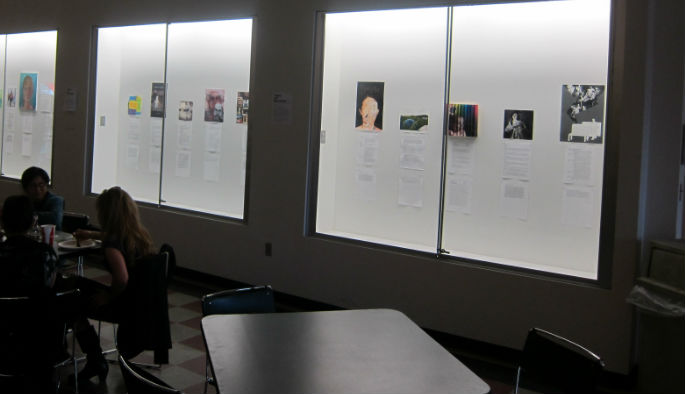
Methods
We used the extended case method, wherein our main goal was "to uncover patterns, determine meanings, construct conclusions and build theory" from specific observations (Patton & Applebaum, 2003, p. 67). As a visual arts educator and a special educator, we examined the final assignments themselves as constructions of ableism, as evidence of learning. We did not analyze the formal characteristics of either the visual artworks or the written statements, because our curricular aims did not include craft or composition skill development, nor did we aspire to generate new theory on visuality or pedagogy. Our aim has been to focus on the learning processes and outcomes of novice students as they attempt to understand ableism through making and writing about art in order to inform our course pedagogy. To this end, we did consider the concepts and intentions of the artworks as well as the written statements. In many cases, the quality of art and writing were similar, reflecting effort, depth of thought, and learning, but in other cases the quality of art and writing were disproportionate, likely due to innate or learned skills.
Using a three-point, Likert-type analytic rubric, we assessed the final assignments in each of the following categories:
- Representation of diversity: The final artwork and statement recognizes disability as a normal aspect of human existence that may yield positive benefits including culture.
- Sociopolitical Representation & Critical Reflection: The final artwork and statement conveys a failure of our social system or major barrier in society encountered by persons with disabilities; or the statement alludes to a personal role/complicity in perpetuating ableism (able-bodied privilege).
- Social Justice/Opportunity/Responsibility to Act: The final artwork and statement attempts to shape/challenge attitudes, programs, policies, or physical space to foster inclusion. The artwork creates a moment of "cognitive dissonance," promoting reflection and change.
We used the rubric to identify where each work needed improvement, met expectations, or exceeded expectations.
Discussion of Data
Regarding Wilson and Lieberman's (2000) three stages—Exposure, Experience, Ownership—the data suggest that the course allowed our students to progress through all three categories. Student artists' statements indicate that they range from having very little contact with disabled people to identifying as disabled themselves or having several close friends or family members who were disabled. The students who were most earnest about disability rights and who we assessed as exceeding project expectations typically identified as disabled or had substantial interactions with disabled people prior to the project. Field notes from class discussions indicated that students had almost no exposure to Disability Studies concepts, including ableism. While our project mainly targeted the exposure stage, the open-ended, creative nature of the project enabled students in all stages to make critical strides in their awareness and understanding of ableism and disability in general.
Select pieces are presented below to demonstrate the evolution of our students' understanding of ableism. As stated above, students varied in their exposure to disability and their artistic expressions of ableism. While none of the students were artists, per se, the combination of visual art and written statements allowed us to assess students' conceptualization of ableism. Proficiency varied from elementary conceptualization of ableism to advanced conceptualization in multiple categories of the rubric with no instances of intolerance or resistance, bolstering Hussy's (2010) findings.
Elementary Conceptualization of Ableism
Figures 2 and 3 demonstrate an elementary understanding of ableism through appeals for social inclusivity. While the pieces are both positive in their intention, the representation of ableism as a discriminatory practice where active reflection and social change are needed is missing. The artist in Figure 2 states that the picture "represents how PWDs [people with disabilities] should not be left out. We are all part of one world and without certain pieces we would not be a complete puzzle. No one deserves to be discriminated against." While the statement is positive in its intention, this is a one-dimensional representation of the ableism and lacks the connection to the discriminatory experience. While Figure 3 does make the connection to a discriminatory experience, labeling persons with disabilities, the piece lacks a deeper understanding of ableism demonstrated by the student's statement "No one should have a label put on them because we are all the same." In fact, we are not all the same, and if we value a diverse society we should not want to all be the same. Inclusion of persons with disabilities in society is about valuing diversity and ensuring equality (i.e., allowing everyone equal opportunity).
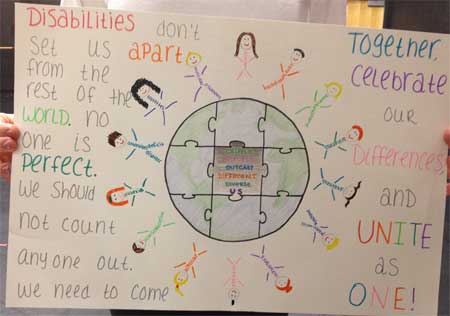
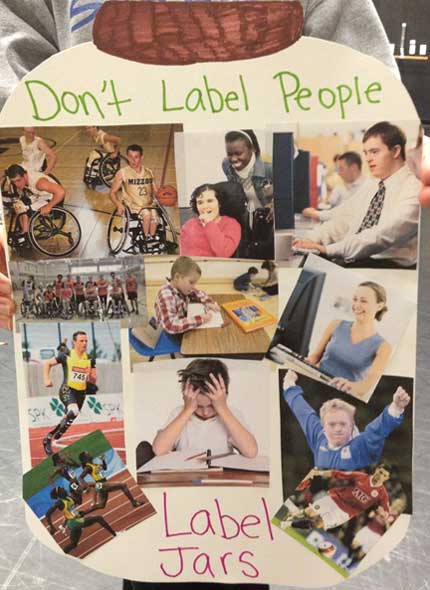
Figures 4 and 5 also demonstrate an elementary conceptualization through the promotion of sport and ability. While the message of disability as a source of strength is preferable to pity, it is a one-dimensional representation of the experience of disability and lacks sociopolitical understanding of ableism. The artist of Figure 4 states that the artwork
is showing that people with disabilities are just like you and me. One has a prosthetic leg and the other girl does not. Nothing is stopping the girl with the disability. She went for a morning run just like you would do.
In teaching ableism, one of the first conversations that we had with students involved recognizing that people with disabilities are like everyone else, including oneself. This shift from an "Other" to an "us" perspective signifies the first step to owning ableist actions and a beginning understanding, and sometimes outrage, about the discrimination that disabled people experience. Figure 4 conveys a more active and positive image of disability than Figures 2 and 3.
The artist's statement for Figure 5 makes the important connection between social language and oppression: "Ableism is the discrimination against individuals with disabilities, not just through acts, but also in words. It labels and defines those in society by their physical state and ability, often what is assumed simply through sight." However, the choice of words for the artwork, such as "abilities of the so-called disabled" fails to make this point clear and arguably confuses the intention of the piece.
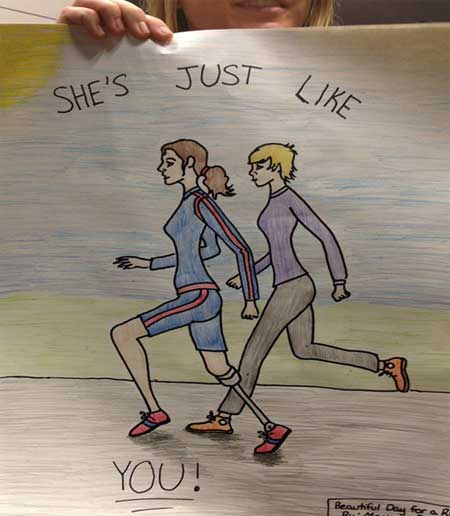
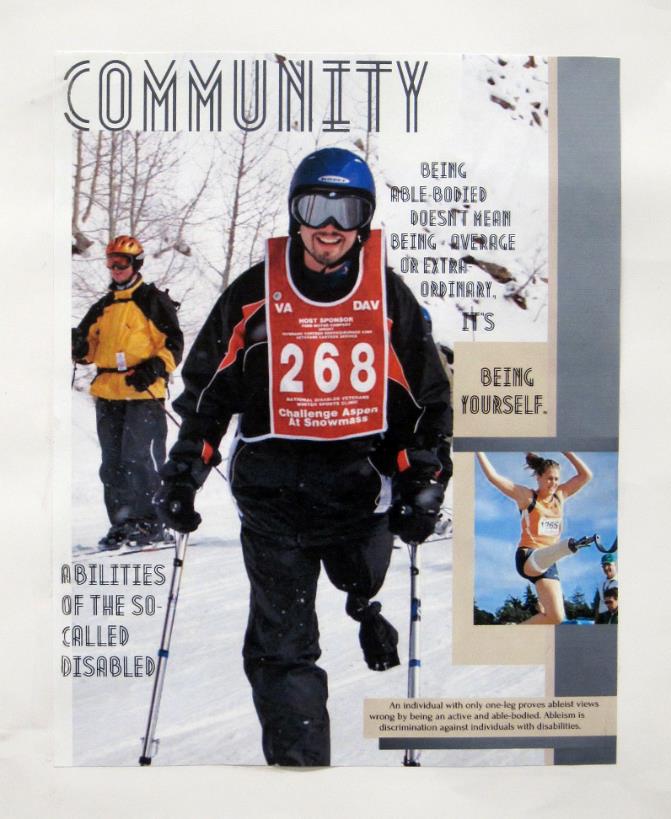
Lastly, several students created pieces using methods to simulate impairment, such as painting with their non-dominant arm (Figure 6) or blindfolded, which also demonstrate an elementary understanding of ableism. In addition to the works neglecting critical attention to ableism, the approach of simulation is fundamentally problematic. Disability Studies scholars and advocates routinely discourage the use of simulation activities in classrooms, as they do not lead to long-term understanding of disability, do not emulate what it is like to adapt to and live with an impairment, and do not engender a sense of sociocultural oppression.
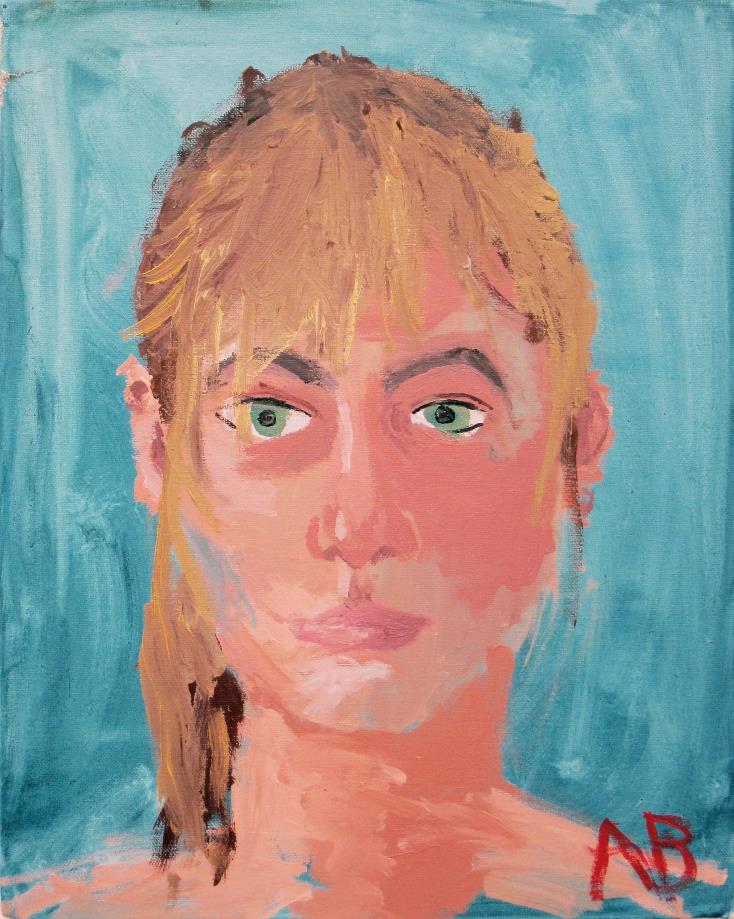
Coming from education fields, we recognize such tendencies as reflecting the aims of traditional Special Education in mainstreamed public schools. The works we discussed are testimony to both the positive advancements that mainstreaming in part has brought about—that blatant, intentional oppression of disabled people is undesirable and unacceptable—as well as the limitations of mainstreaming, which perpetuates the presumption that classroom membership belongs to "normal" able-bodied, able-minded students. These works not only show limited knowledge of ableism, but limited learning, suggesting the complacency of students who believe that bigotry has been resolved in the U.S. Perhaps the most striking and disappointing aspect of these works is not their superficiality, but that students who created them believed that they successfully addressed ableism. This suggests that the challenge post-secondary educators currently face when teaching ableism to typical college students, as we recommend, may no longer be angry resistance, but an inability to perceive ableism amid a utopian imaginary, let alone something for which everyone is responsible.
It was inconsequential whether or not the above works, and others like them, were deficient in one or multiple categories of ableism. The projects that were substantially problematic in any one category did not communicate an overall critical message about ableism and indicated that some students did not grasp the concepts.
Advanced Conceptualization of Ableism
In contrast to the one-dimensionality of the elementary works, the advanced works expressed ableism in a variety of complex ways, thus making a general, linear assessment strategy inadequate. As the literature reveals the complexities of ableism, our assessment of the works through the rubric we developed suggest that student artists tended to emphasize specific aspects of ableism while ignoring others. In particular, it became evident that it was difficult to simultaneously address representation of disability and social justice/opportunity/responsibility to act. Perhaps part of this is the nature of the project, a static, two-dimensional artwork, which therefore could not address both of these topics in ways that would be easier through time-based media, such as video and literature, or spatial media, such as sculpture, critical design, architecture, and installation. On the other hand, the project lent itself to solutions that could either strongly address a particular aspect of ableism, or which could engage the complex dynamics of ableism.
Criticism of ignorance about disability experiences and ableism.
Many students chose to critique deliberate or unintentional ignorance of the experience of disability or sociocultural ableism. Figures 7 and 8 depict society as dark silhouette figures who look away from the richness, depth, and strengths of persons with disabilities. On one hand, these images unknowingly bolster blindness metaphors: society refuses to "see" the fullness of disability, which is visible through light, color, and interesting detail. These images do not challenge ableist representation. On the other hand, these works do recognize sociopolitical and responsibility aspects of ableism. For example, the student artist who created Figure 7 remarked, "My artwork represents AB [able-bodied] ignorance. We as AB are very ignorant to PWDs," while the artist of Figure 8 claimed that people in society "turn their backs to people with disabilities [, …] pretend[ing] to care but then they judge or only care when it is convenient for them."


We also identified several works that conveyed a more internalized conceptualization of ableism, presumably due to the artists' intimate experiences as people who are disabled or close to someone who is disabled. Figures 9 and 10, for example, employ similar artistic strategies with different goals. Figure 9, titled "Bandage the Damage" after Demi Lovato's song Fix a Heart, "was inspired by people who are put down by disability and also by my boyfriend's father who was severely depressed and committed suicide," and it is "about confronting ableism in the sense that you can't just cover up the damage that is done because it doesn't fix what is already done." Figure 10, by contrast, is a torn and embroidered digital print, using the theme "FRACTURE" to challenge stigma and generalizations about disabled people, who "seem to be viewed as weak, and needing help, or needing to be fixed; a fracture to the system," when, arguably, "every single one of us is broken in our own unique way living and breaking a very different definition of normal." While Figure 9 recognizes the damage caused by ableist oppression, and Figure 10 challenges the ableist presumption that disabled people are damaged; both works challenge viewers to re-think their conceptualization of disability. As artworks about disability, it is unlikely that viewers would interpret the works in the way the artists describe them, but both works present disability representation in an unsettling way that calls for deeper contemplation and reconciliation.

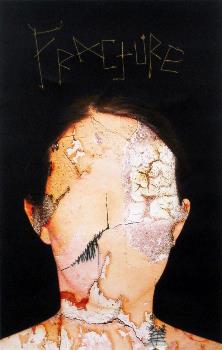
Similarly, the artist of Figure 11 juxtaposes three silhouettes representing ability and disability in disparate ways:
This piece confront [sic] the concept of ableism and the idea that a person is first seen for their ability or disability. You will see the person's silhouette is interrupted by the classic symbol for disability to show that able-bodied people look at a disabled person and see one thing: the disability. This is their first impression, and more often than not a person does not stop to consider the idea that this person is a lot more than, for instance just a person in a wheelchair. The shadow is a dancer to confront the idea that a person is more than what they appear to be on the surface, that their abilities transcend the stereotypical stigma that a person is defined by their disability and nothing else. People should see the person not the disability.
The chosen images are somewhat problematic, but together the images ask viewers to consider their presumptions about the extreme notions of able and disabled bodies.

Reversing the ableist gaze.
Others (Figures 12-14) conveyed a message of reversing the gaze, approaching what Eisenhauer (2007) refers to as "staring back" in her article on challenging ableism through disability performance art:
Disability performance artists raise important questions regarding the social construction of the normal/abnormal dichotomies through an examination of the cultural inscription of their own bodies. These artists construct sites of critical intervention, testimony, and questioning by situating their own bodies in the very spaces that serve as sources of their objectification. (p. 12)
While many of our students were non-disabled and none were professional artists, several strived diligently to have the viewer understand the perspective of persons with disabilities and the social and environmental barriers that they experience.
Figure 12, for example, is a photo collage of inaccessible public entrances in the artist's community, designed to "document inaccessibility in our community and increase awareness of the hidden inequalities within our society." The artist describes in detail the physical process of obtaining the items she wanted, after which, while exiting the store, she noticed an out-of-breath wheelchair user entering, after negotiating the ramp. This led to an epiphany:
It donned on me, "How does he get the cereal off the top shelf or choose the least bruised and battered tomatoes?" I began to look at the community through the perspective of an individual in a wheelchair, and focused on the everyday ordinary things I take for granted because of my ability to walk.
The artist was "surprised to find that most of these businesses" were extremely inaccessible, something she had never realized. Her project demonstrated the worth of the assignment, which afforded the opportunity and permission to experience and visualize the ableist environment in which she lives and participates, in a way that differed from the opportunities that reading, writing, and other academic endeavors provide.
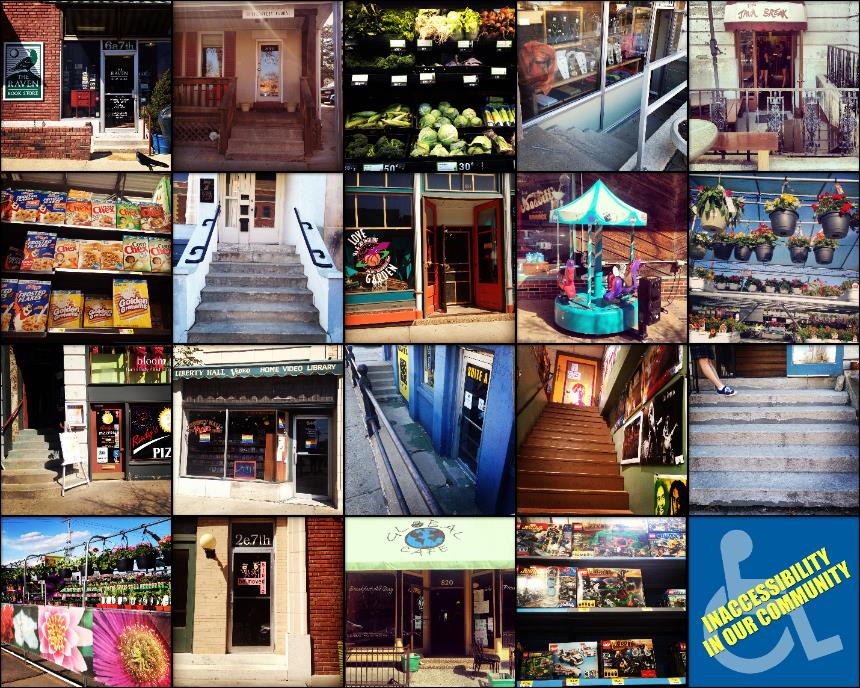
Figure 13 was one of the most sophisticated projects in terms of conceptual depth. By placing viewers in the voyeuristic gaze of looking under a table at women wearing skirts, the artist implicates the viewers' problematic gaze without demanding that they quickly turn away. This position also "represent[s] how able-bodied often see pwds as beneath them [while] in essence these women (or what we imagine above the table) are no different." Indeed, the image asks viewers to imagine the more appropriate eye-level scene of four women sitting at a table, indistinguishable by virtue of their visibly non-disabled, well-dressed bodies. Also key to the success of Figure 13, in contrast with the joggers in Figure 5, is that this group of friends, who are also enjoying luxury footwear, are not engaged in an activity that would justify staring. The disabled subject is not directly utilizing her prosthetic, which draws attention to the viewer's discomfort with her display of the prosthetic and the red shoes, extravagant because of their aesthetic rather than utilitarian function. In this case, the nondisabled artist is not pretending to represent the disabled subject, but rather to place her own body within the familiar, public context that disabled and nondisabled people share. Like the psychiatrically disabled bodies in Petra Kuppers' Traces, whose silence implicates the audience, the rendered, disabled body in Figure 13 "mak[es] the viewer aware of their own expectations of how a [disabled] body should perform," and thus "viewers become aware of their own bodies as both viewers and as objects of the gaze" (Eisenhauer, 2007, p. 17).
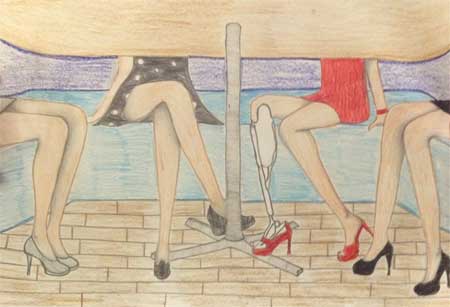
Figure 14 was created by a student who experiences an invisible disability. Her artwork depicts someone watching television programming that includes disabled characters, which are played sometimes by disabled actors but more often by nondisabled actors. The artist explains, "Disabilities can be both visible and hidden; you can't necessarily tell someone is disabled just by looking at them." Additionally, the man on the couch is "purposefully portrayed" as "being neither obviously disabled nor obviously non-disabled," suggesting the dis/ability equivalence of androgyny. The artist positions herself directly as the anonymous viewer of the TV viewer and indirectly as the disabled-or-nondisabled (male) TV viewer, suggesting that disability can never be fully known through seeing and that disability can never be fully represented through any mode of visual culture, including performance. The artwork alone does not communicate the fullness of this concept, but the perplexity of the imagery is successful in the artist's intention to critique the fact that "Representation of disabled people in the media affects the thoughts, opinions, and views of everyone, even if they have no real-life interaction with people with disabilities. The media effects our perception of the world and ourselves whether we wish to admit it or not."
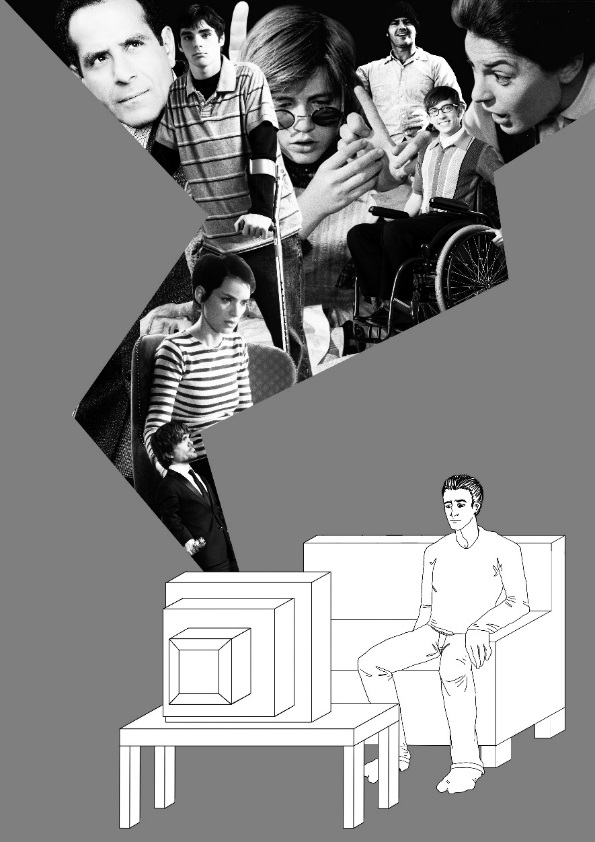
Conclusions
In this study we endeavored to incorporate Disability Studies material in three undergraduate courses to promote an understanding of ableism. From a pedagogical perspective, we sought to introduce the concept of ableism through the use of varied curricular materials, such as research studies, online video clips, films, and short stories. In essence, we sought to expose our students to the issues that persons with disabilities face, a brief history of the disability rights movement, and the constraining barriers of an ableist society. We knew that some of our students were predisposed to these ideas because they had a family member with a disability or experienced disability themselves; we created opportunities for all students to be challenged by the curriculum with the goal of deepening their understanding of ableism. Respectively, our goals were for students to recognize disability as just one aspect of human existence, the sociopolitical nature of ableism (it conveys a failure or barrier encountered in society), and that, as members of a just society, we have a responsibility to act to shape or challenge the attitudes, programs, policies, and/or physical space to foster inclusivity.
Through the analysis of our student's final assignments, where they were required to explore the concept of ableism and translate their views into a compelling piece of art, we found that, using Columna et al.'s (2009) pedagogical outline for assessing disability awareness (Exposure, Experience, and Ownership), all students were able to make critical strides in their understanding of ableism and disability in general. In reflecting upon our own teaching practices, we believe that building a safe, critical environment over time is imperative, but finding the balance between empathy and criticality, between patience and progress, is difficult and nebulous, demanding at least as much self-criticality of teachers as of students.
In summary, we recommend the continued use of Vescio, Bondy and Poekert's (2009) pedagogy of transformation of which we based our curriculum. Future courses should seek to provide opportunities for students to be exposed to the concept of ableism through multiple means (varied curricular materials) in a safe learning environment that values intuitive ways of knowing (introspection and personal experience) and encourages students to step out of their comfort zone to examine their and society's roles in oppression. Lastly, we encourage educators to adopt our strategy of active participation. Our final assignment not only allowed for student creativity and choice, it also incorporated a real-life, sociopolitical experience for our students through their public exhibition of their pieces to our larger university communities. Our hope is that this experience will compel our students to take an active role in fostering inclusivity beyond the scope of this project.
References
- Barney, M. (Director, Writer). (2002). Cremaster 3: The order [Motion picture]. U.S.: Palm Pictures.
- Causton-Theoharis, J., & Burdick, C. (2008). Paraprofessionals: Gatekeepers of authentic art production. Studies in Art Education, 49(3), 167-182.
- Columna, L., Arndt, K., Lieberman, L., & Yang, S. (2009). Using online videos for disability awareness. Journal of Physical Education, Recreation & Dance, 80(8), 19-24.
- Derby, J. (2012). Art Education and Disability Studies. Disability Studies Quarterly, 32(1). Retrieved from http://dsq-sds.org/article/view/3027/3054
- Derby, J. (2015). Disability Studies pedagogy in a U.S. Art Education curriculum. In M. Kallio-Tavin & J. Pullinen (Eds.), International conversations on Finnish art education. Helsinki, Finland: Aalto University Press.
- Derby, J. (in press). Confronting ableism: Disability Studies pedagogy in pre-service Art Education. Studies in Art Education.
- Disability culture profile: Cheryl Marie Wade. (n.d.). Retrieved from http://www.disabilityhistory.org/dwa/edge/curriculum/cult_prof_wade.htm
- Efland, A. D. (2002). Art and cognition: Integrating the visual arts in the curriculum. New York, NY: Teachers College.
- Eisner, E. W. (2002). The arts and the creation of the mind. New Haven, CT: Yale University Press.
- Eisenhauer, J. (2007). Just looking and staring back: Challenging ableism through disability performance art. Studies in Art Education, 49(1), 7-22.
- Esses, V. M., & Hodson, G. (2006). The role of lay perceptions of ethnic prejudice in the maintenance and perpetuation of ethnic bias. Journal of Social Issues, 62(3), 453-468.
- Fiske, S. T. (1998). Stereotyping, prejudice, and discrimination. In D. T. Gilbert, S. T. Fiske, & G. Lindzey (Eds.), The hand-book of social psychology: Vol. 2 (4th ed., Vol. 2, pp. 357-411). New York, NY: McGraw-Hill.
- Guay, D. (1994). Art educators integrate: A challenge for teacher preparation. Teacher Education and Special Education, 17(3), 181-191.
- Hockenberry, J. (2008). From Public transit. In C. Lewiecki-Wilson & B. J. Brueggemann (Eds.), Disability and the teaching of writing: A critical sourcebook (pp. 257-261). Boston, MA: Bedford/St. Martin's.
- Hussey, H. F. (2010). Reducing student prejudice in diversity-infused core psychology classes. College Teaching, 58, 85-92.
- Karr, V. L. L., & Weida, C. (2013). Superhero comic books as frameworks for inclusivity and advocacy for youth with disabilities. Journal of Cultural Research in Art Education, 30. Retrieved from http://www.jcrae.org/journal/index.php/jcrae/article/view/4/1
- McLean, M. A. (2011). Getting to know you: The prospect of challenging ableism through adult learning. New Directions for Adult and Continuing Education, 132, 13-22. doi:10.1002/ace.427
- Mezirow, J. (2000). Learning to think like an adult: Core concepts of Transformation Theory. In J. Mezirow (Ed.), Learning as transformation: Critical perspectives on a theory in progress (pp. 3-34). San Francisco, CA: Jossey-Bass, Inc.
- Mezirow, J. (1997, Summer). Tranformative learning: Theory to practice. New Directions for Adult and Continuing Education, 74, 5-12.
- Mullins, A. (2009, October). The opportunity of adversity [Video file]. Retrieved from https://www.ted.com/talks/aimee_mullins_the_opportunity_of_adversity
- Patton, E., & Appelbaum, S. H. (2003). The case for case studies in management research. Management Research News, 26(5), 60-71.
- Price, M. (2011). Mad at school: Rhetorics of mental disability and academic life. Ann Arbor, MI: The University of Michigan Press.
- Schiller, M. (1999). Access to art education: Ethical and legal perspectives. In A. L. Nyman & A. M. Jenkins (Eds.), Issues and approaches to art for students with special needs (pp. 7-16). Reston, VA: National Art Education Association.
- Vescio, V., Bondy, E., Poekert, P. E. (2009). Preparing multicultural teacher educators: Toward a pedagogy of transformation. Teacher Education Quarterly, 36(2), 5-24.
- Villegas, A. M., Lucas, T. (2002). Educating culturally responsive teachers: A coherent approach. Albany, NY: State University of New York Press.
- World Health Organization & World Bank. (2011, June 9). World report on disability. Retrieved from http://www.who.int/disabilities/world_report/2011/report.pdf
- Wilson, S., & Lieberman, L. (2000). DisAbility awareness in physical education. Strategies: A journal for physical and sports educators, 13(6), 12, 29-33. doi:10.1080/08924562.2000.10591453

